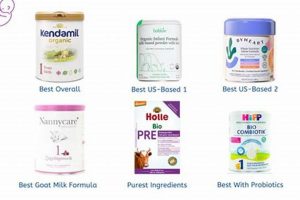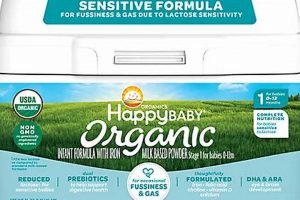The printed date on infant feeding products signifies the manufacturer’s assurance of the nutritional content and quality of the formula up to that point. It represents the period during which the product is guaranteed to contain the listed nutrients at the stated concentrations and maintain its physical properties, such as consistency and solubility. For example, a container with a date of January 1, 2025, indicates this guarantee extends until that date.
Adhering to this date is crucial for several reasons. Primarily, it ensures the infant receives the intended levels of essential vitamins and minerals vital for proper growth and development. Over time, the nutritional value may degrade, rendering the formula less effective. Furthermore, the date indicates the period for which the product’s safety and integrity have been verified, minimizing the risk of spoilage or contamination. Historically, manufacturers have established expiration dates based on rigorous testing and stability studies to safeguard infant health.
Understanding the significance allows for informed decisions regarding formula preparation and storage. Subsequent sections will delve into guidelines for proper storage, the potential risks of using products past the specified time, and the current regulatory standards governing the establishment of these dates. This information empowers caregivers to make responsible choices, prioritizing the well-being of the infant.
Important Considerations Regarding Formula Expiration
The following are critical points to consider regarding the usage and storage of infant formula, with particular attention to the printed expiration.
Tip 1: Always Inspect the Date: Prior to preparing formula, consistently verify the printed date. Discard any product that has passed this date, regardless of appearance or smell.
Tip 2: Proper Storage is Essential: Store unopened containers in a cool, dry place away from direct sunlight. Elevated temperatures can accelerate degradation and reduce the shelf life, even before the indicated date.
Tip 3: Use Opened Containers Promptly: Once opened, adhere strictly to the manufacturer’s guidelines for usage duration. Typically, this timeframe is significantly shorter than the overall shelf life. Discard any remaining formula after the recommended period, usually within one month.
Tip 4: Mixed Formula Requires Immediate Refrigeration: Prepared formula, whether from powder or concentrate, should be refrigerated immediately if not consumed. Discard any prepared formula that has been at room temperature for more than two hours.
Tip 5: Do Not Freeze Formula: Freezing is not recommended as it can alter the composition and texture of the formula, potentially affecting its nutritional value and palatability.
Tip 6: Be Wary of Damaged Packaging: Inspect the container for any signs of damage, such as dents, rust, or leaks. Compromised packaging may indicate contamination, even if the expiration date has not been reached. If damage is apparent, discard the product.
Tip 7: Heed Recall Notices: Stay informed about potential recalls. Manufacturers and regulatory agencies issue recalls for products suspected of contamination or quality issues. Promptly discard any recalled product, irrespective of the printed date.
Adhering to these guidelines minimizes potential risks associated with compromised or degraded formula, thereby safeguarding infant health and ensuring consistent nutritional intake.
The subsequent section will provide information on regulatory oversight and the implications of using expired product.
1. Safety
The relationship between infant formula and safety is paramount, rendering the expiration date a critical element in ensuring the product’s suitability for consumption. This date represents the manufacturer’s guarantee that the formula remains safe and nutritionally adequate up to that specific point in time. Beyond this date, the integrity of the product cannot be assured, potentially exposing infants to various risks.
- Microbial Contamination Risk
Expired formula may harbor harmful bacteria. While formula production processes aim to sterilize the product, time can facilitate microbial growth, especially if the packaging is compromised or storage conditions are inadequate. Consuming contaminated formula can lead to gastrointestinal distress, infections, and other health complications in infants, who are particularly vulnerable due to their immature immune systems.
- Nutrient Degradation Impact
Over time, the nutritional content of formula degrades, meaning it loses safety and is not as effective. Vitamins, minerals, and essential fatty acids can break down, reducing their bioavailability and potentially leading to nutritional deficiencies in infants. These deficiencies can negatively impact growth and development, affecting cognitive function, bone health, and immune response.
- Chemical Changes and Stability
The chemical composition of formula can alter as it ages, leading to the formation of potentially harmful compounds. The fats in the formula can become rancid, affecting taste and digestibility. Proteins can also undergo changes, potentially reducing their nutritional value and increasing the risk of allergic reactions. The expiration date is established to ensure the formula remains chemically stable and safe for consumption.
- Packaging Integrity
The expiration date is linked to the integrity of the packaging. Manufacturers design packaging to protect the formula from external contaminants and environmental factors, such as moisture and light. Over time, packaging can degrade, compromising its protective function. This can expose the formula to contamination and accelerate the degradation process. Using formula from damaged or expired packaging increases the risk of safety issues.
In summary, the various facets highlight why adhering to the printed date is vital. Failure to do so can compromise safety due to microbial contamination, nutrient degradation, chemical changes, and compromised packaging integrity, posing significant health risks to infants. It is therefore imperative for caregivers to always check the date and follow recommended storage guidelines to ensure the formula’s safety and efficacy.
2. Nutrient Degradation
Nutrient degradation is a significant concern in the context of infant formula. The expiration date on the container reflects the period during which the manufacturer guarantees the formula retains its declared nutrient profile. Beyond this date, the essential vitamins, minerals, and other vital components may degrade, reducing the formula’s nutritional value.
- Vitamin Stability
Vitamins, particularly water-soluble vitamins like Vitamin C and B vitamins, are susceptible to degradation over time. Factors such as exposure to light, heat, and oxygen can accelerate this process. As these vitamins diminish, the formula may no longer provide the intended levels necessary for infant growth and development. For instance, insufficient Vitamin C intake can impair collagen synthesis and immune function, potentially impacting the infant’s health.
- Amino Acid Breakdown
Amino acids, the building blocks of protein, are also subject to degradation. While protein itself may remain relatively intact, individual amino acids can break down or undergo chemical modifications, reducing their bioavailability and nutritional value. This can impact protein synthesis and overall growth, particularly in the case of essential amino acids that the infant cannot synthesize. For example, degradation of tryptophan could affect serotonin production, potentially influencing sleep patterns and mood.
- Fatty Acid Oxidation
Fats, especially unsaturated fatty acids like DHA and ARA, are prone to oxidation. This process leads to the formation of rancid compounds, which can affect the taste and odor of the formula, making it less palatable. Oxidation also reduces the nutritional value of these essential fatty acids, which are crucial for brain development and visual acuity. The presence of antioxidants in the formula aims to mitigate oxidation, but their effectiveness diminishes over time, especially after the expiration date.
- Mineral Precipitation and Bioavailability
Minerals, although generally more stable than vitamins, can undergo chemical changes over time, leading to precipitation or reduced bioavailability. This means that even if the mineral is still present in the formula, it may not be readily absorbed and utilized by the infant’s body. Factors like pH changes and interactions with other components can influence mineral solubility and absorption. For example, reduced iron bioavailability can contribute to iron deficiency anemia, affecting cognitive development and immune function.
The degradation of nutrients over time underscores the importance of adhering to the expiration date. Consuming formula beyond this date may expose infants to the risk of nutritional deficiencies, impacting their growth, development, and overall health. While the formula may still appear visually acceptable, the compromised nutritional profile renders it unsuitable for infant feeding. Therefore, consistent verification of the printed date is essential to ensure the infant receives the intended nutritional benefits.
3. Storage Conditions
Appropriate storage significantly impacts the shelf life and safety of infant formula, and consequently, the validity of the manufacturer’s date printed on the container. Environmental factors influence the rate at which nutrient degradation and potential contamination occur.
- Temperature Control
Elevated temperatures accelerate chemical reactions, including nutrient breakdown and microbial growth. Storing formula in warm environments, such as near a stove or in direct sunlight, reduces its shelf life and increases the risk of spoilage, irrespective of the date printed. Maintaining a consistent, cool temperature, ideally below 75F (24C), is crucial.
- Humidity Levels
High humidity introduces moisture, which can compromise the integrity of the formula and its packaging. Powdered formula is particularly susceptible to clumping and microbial contamination in humid conditions. Proper storage in a dry environment is essential to prevent these issues. Desiccants, where included in the packaging, should remain intact until first use.
- Light Exposure
Exposure to direct sunlight or artificial light can degrade light-sensitive nutrients like riboflavin (Vitamin B2) and Vitamin D. Light can also promote oxidation of fats, leading to rancidity. Storing formula in its original packaging in a dark, or at least shaded, location minimizes this exposure and preserves nutrient quality.
- Packaging Integrity
The original packaging is designed to protect the formula from environmental factors. Damaged or compromised packaging allows moisture, air, and contaminants to enter, accelerating degradation and increasing the risk of spoilage. Inspect packaging for any signs of damage, such as dents, tears, or leaks, before using the formula. Avoid transferring formula to other containers unless specifically instructed by the manufacturer, as this can compromise its protection.
Considering these elements allows for informed decisions regarding formula preservation. Optimal storage minimizes the risk of premature degradation and ensures the infant receives the intended nutritional benefits until the printed date. When storage conditions are not properly maintained, the formula might not be safe to consume, even if the expiration date has not yet passed.
4. Manufacturer Guarantee
The date printed on infant formula packaging is inextricably linked to the manufacturer’s guarantee. This date is not arbitrary; it represents a commitment by the manufacturer that the product will meet specific quality and nutritional standards up to that point, provided the product is stored correctly. It is a legally binding assurance regarding the product’s safety and efficacy.
- Nutritional Adequacy Assurance
The manufacturer’s guarantee ensures the formula contains the declared amounts of essential nutrients, such as vitamins, minerals, proteins, and fats, up to the specified date. This assurance is based on extensive stability testing and quality control measures. For example, manufacturers conduct shelf-life studies to determine how long vitamins like Vitamin D remain at acceptable levels. If the formula is consumed before this date and stored as directed, the manufacturer warrants that the infant will receive the nutrients listed on the label in adequate quantities. Post this date, the manufacturer no longer assures this adequacy.
- Safety and Purity Commitment
Beyond nutritional content, the manufacturer’s guarantee extends to the safety and purity of the formula. Manufacturers employ stringent processes to minimize the risk of contamination by bacteria, heavy metals, or other harmful substances. The expiration date reflects the period during which the manufacturer can confidently assert the product is free from unacceptable levels of these contaminants, assuming proper storage. For instance, infant formula manufacturers must adhere to strict regulations regarding lead content, and the expiration date is tied to maintaining compliance with these regulations. Once the expiration date passes, the risk of degradation or contamination increases, voiding the manufacturer’s safety commitment.
- Physical Properties Integrity
The manufacturer’s guarantee also encompasses the physical properties of the formula, such as its texture, solubility, and overall appearance. These properties can change over time, particularly if the formula is exposed to moisture or extreme temperatures. The printed date assures that the formula will mix properly and remain free from undesirable changes like clumping or discoloration until that time. Consider powdered formulas; the manufacturer warrants that the powder will dissolve completely in water without forming lumps up to the expiration date, provided storage conditions are met. After this date, these properties may no longer be assured.
- Legal Liability and Recalls
The manufacturer’s guarantee is not only a commitment to quality but also carries legal implications. If a product causes harm due to a defect or contamination before the expiration date, the manufacturer may be held liable. Recalls are often issued for products that fail to meet safety or quality standards within their guaranteed shelf life. The expiration date thus serves as a benchmark for legal responsibility. For example, a manufacturer may issue a recall if testing reveals a batch of formula contains elevated levels of bacteria before its expiration date. Consuming formula past its expiration date shifts the risk and responsibility away from the manufacturer.
The manufacturer’s guarantee, embodied in the expiration date, is a multifaceted assurance of nutritional adequacy, safety, physical properties, and legal accountability. This date is not merely a suggestion but a critical marker reflecting the manufacturer’s commitment to providing a safe and nutritionally complete product for infant feeding. Understanding its significance is paramount for caregivers making informed decisions about formula use.
5. Regulatory Compliance
The establishment of an expiration date on infant formula is heavily influenced by regulatory compliance. Governmental bodies and international organizations mandate specific testing and labeling requirements to ensure product safety and nutritional adequacy. These regulations dictate the methodologies used to determine shelf life, including stability testing under various conditions to assess nutrient degradation and potential microbial growth. Manufacturers must adhere to these protocols to legally market their products. Non-compliance can result in product recalls, fines, and reputational damage. For instance, the U.S. Food and Drug Administration (FDA) sets forth guidelines for infant formula manufacturing, mandating specific nutrient levels and labeling requirements, including a clearly marked expiration date reflecting the outcome of stability testing. This regulatory oversight serves as a crucial mechanism to protect infant health by setting safety standards.
The implementation of regulatory compliance measures directly affects the practical application and interpretation of the product’s expiration date. For example, manufacturers are required to conduct accelerated aging studies, exposing the formula to high temperatures and humidity levels to simulate long-term storage conditions. The data from these studies informs the setting of the expiration date, providing a buffer period to account for potential variations in consumer storage practices. Furthermore, regulatory bodies require manufacturers to monitor their products post-market, tracking adverse events and consumer complaints. This ongoing surveillance allows for continuous improvement and refinement of safety protocols, potentially leading to adjustments in shelf-life determinations. An instance of this is when a manufacturer, following a regulatory audit, finds inadequacies in their packaging integrity, it may lead to stricter expiration guidelines.
In summary, regulatory compliance is integral to the establishment and enforcement of expiration dates on infant formula. These regulations, encompassing rigorous testing, labeling mandates, and post-market surveillance, aim to mitigate risks and ensure the product remains safe and nutritionally adequate throughout its shelf life. Challenges persist in harmonizing international regulatory standards and keeping pace with innovations in formula manufacturing and packaging. Despite these challenges, strict adherence to regulatory requirements remains paramount in safeguarding infant health and maintaining consumer trust in infant formula products.
6. Potential Harm
The fundamental connection between potential harm and the printed date on infant formula underscores a critical aspect of infant health. The date represents the limit beyond which the manufacturer can no longer guarantee the formula’s safety and nutritional adequacy, thereby indicating the onset of increased potential for harm. This harm can manifest in several ways, primarily through nutrient degradation, microbial contamination, and chemical changes. For instance, expired formula may lack sufficient levels of essential vitamins and minerals required for proper infant development, leading to nutritional deficiencies. Furthermore, the risk of bacterial growth, such as Cronobacter sakazakii, increases in expired products, potentially causing severe infections, particularly in vulnerable infants. A concrete example involves cases where infants consuming expired formula contracted Salmonella infections, highlighting the potentially severe consequences of disregarding the printed date. The practical significance lies in understanding that the date serves as a critical safety boundary, and its disregard carries tangible risks.
The causes of potential harm stemming from expired formula are multifaceted. Time-related degradation of nutrients is inevitable, even under optimal storage conditions. Environmental factors, such as temperature fluctuations and humidity, accelerate these processes. Moreover, packaging integrity can deteriorate over time, allowing for the introduction of contaminants. Consider cases where compromised packaging of expired formula led to mold growth and subsequent respiratory distress in infants. Understanding these causes allows caregivers to make informed decisions regarding formula usage and storage. Proper storage practices, including keeping formula in a cool, dry place and inspecting packaging for damage, can mitigate some risks. However, once the printed date has passed, the potential for harm escalates significantly, regardless of storage conditions.
In conclusion, the existence of a “baby formula expiration date” is directly linked to mitigating “potential harm” to infants. The date indicates the period during which the manufacturer warrants safety and nutritional value, supported by rigorous testing and regulatory oversight. Disregarding the date increases risks associated with nutrient deficiencies, microbial contamination, and chemical changes. While proper storage practices can help preserve formula quality, adherence to the date remains paramount in safeguarding infant health. The challenges lie in ensuring consistent understanding and compliance among caregivers, necessitating clear and accessible information regarding the importance of the expiry date in preventing potential harm.
Frequently Asked Questions
The following questions address common concerns and misconceptions regarding expiration dates on infant formula products.
Question 1: What exactly does the date on the container of infant formula mean?
The date indicates the manufacturer’s assurance of the product’s nutritional content and safety up to that specified point in time, assuming it is stored according to the manufacturers directions. The formula’s essential nutrients are guaranteed to be present at the levels stated on the label, and the product should be free from unacceptable levels of contaminants.
Question 2: Is it safe to use infant formula shortly after the date?
Consuming formula after this date is not advisable. The manufacturer’s guarantees regarding nutritional content and safety are no longer valid. Potential risks, such as nutrient degradation and microbial contamination, increase. No advantage exists in using expired formula, given the potential for adverse effects on infant health.
Question 3: What are the risks associated with using expired infant formula?
The use of formula past the printed date presents several risks. The levels of essential nutrients may decline, leading to inadequate nutritional intake. Microbial contamination may occur, potentially causing gastrointestinal illnesses. Chemical changes within the formula can compromise its safety and digestibility. All of these factors pose potential threats to infant health and development.
Question 4: Does freezing infant formula extend its shelf life beyond the date?
Freezing infant formula is not recommended. Freezing can alter the physical properties of the formula, potentially affecting its consistency and nutrient distribution. While freezing might inhibit bacterial growth, it does not prevent nutrient degradation. The manufacturer’s assurance does not extend to frozen formula, and potential adverse effects on infant health remain.
Question 5: Can expired infant formula be donated or used for other purposes?
Expired infant formula should not be donated or used for any other purpose. The safety and nutritional integrity of the product cannot be assured, rendering it unsuitable for consumption or any other application. Disposal is the only appropriate course of action.
Question 6: How can one ensure the safety and quality of infant formula before the date?
To ensure the safety and quality of formula before this date, proper storage is essential. Keep the product in a cool, dry place away from direct sunlight. Inspect the packaging for any signs of damage. Once opened, follow the manufacturer’s instructions for usage duration and storage. Discard any remaining formula after the recommended period.
Adherence to the date is paramount. It represents the manufacturer’s warranty regarding nutritional adequacy and safety. Exceeding this timeframe is not advisable, given the potential risks to infant health.
The following section will explore resources for caregivers needing assistance with infant formula.
The Critical Importance of Adhering to the Baby Formula Expiration Date
This exploration has detailed the multifaceted significance of the baby formula expiration date, emphasizing its role as a manufacturer-validated assurance of nutritional integrity and product safety. The marked date serves as a definitive boundary, beyond which the formula’s essential components may degrade, and the potential for contamination elevates, thereby posing quantifiable risks to infant well-being. Factors influencing the validity of this date, encompassing storage conditions, packaging integrity, and regulatory compliance, have been examined to elucidate the complexities surrounding informed usage.
The stringent adherence to the baby formula expiration date remains a non-negotiable imperative. Continued vigilance and proactive dissemination of this critical information are essential in fostering responsible caregiving practices and safeguarding the health of the most vulnerable population. The future mandates collective responsibility: manufacturers upholding quality control, regulatory bodies enforcing stringent standards, and caregivers prioritizing informed decision-making to ensure optimal outcomes for infant nutrition.







![Best European Baby Formula vs American Options? [Guide] Baby Care 101: Essential Tips for Happy, Healthy Babies Best European Baby Formula vs American Options? [Guide] | Baby Care 101: Essential Tips for Happy, Healthy Babies](https://singlebabies.com/wp-content/uploads/2025/12/th-787-300x200.jpg)